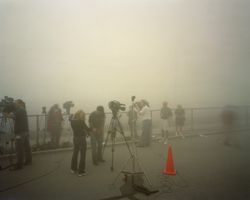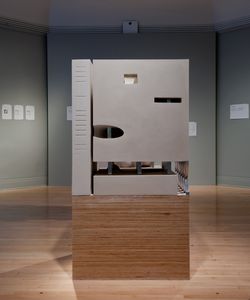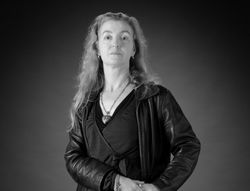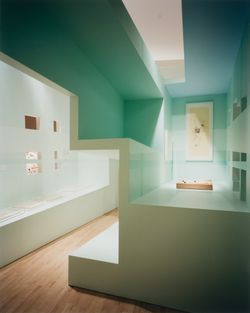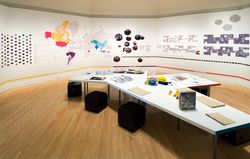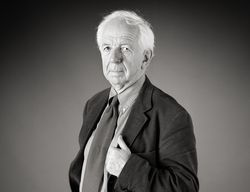Robert Burley, boursier, chercheur principal de la fondation Mellon du CCA et professeur adjoint à la Ryerson University, présente sa conférence « The Architecture of Photography in an Age of Obsolescence». Le programme pour boursiers et chercheurs principaux de la fondation Mellon du CCA a été mis sur pied en 2001 afin d’encourager la recherche de pointe en histoire et(...)
Théâtre Paul-Desmarais
16 septembre 2010, 18h
Robert Burley : « The Architecture of Photography in an Age of Obsolescence »
Actions:
Description:
Robert Burley, boursier, chercheur principal de la fondation Mellon du CCA et professeur adjoint à la Ryerson University, présente sa conférence « The Architecture of Photography in an Age of Obsolescence». Le programme pour boursiers et chercheurs principaux de la fondation Mellon du CCA a été mis sur pied en 2001 afin d’encourager la recherche de pointe en histoire et(...)
Théâtre Paul-Desmarais
DR1974:0002:012:001-049
Description:
- This album contains student drawings by Hubert Rohault de Fleury executed at the École spéciale de peinture, sculpture et architecture, Paris (1798-1802), including drawings for the Grand Prix Competitions of 1800, 1801 and 1802, the Concours d'essai, the Concours d'émulation of 1800 and 1801, and other undetermined competitions. The drawings illustrate all stages of the design and competition process, ranging from preliminary sketches and esquisses to finished renderings, but do not include the renderings submitted to the Grand Prix Competitions. Drawings for the conversion of the Église de la Madeleine into a Temple de la Gloire (ca. 1806-1807) include line and wash drawings. Hubert's 1800 Grand Prix entry for an École nationale des beaux-arts was awarded the "deuxième Grand Prix" and this album includes: the esquisse; a handwritten copy of the programme; 11 large-scale line drawings - sections, elevations, and details of the ornamentation (DR1974:0002:012:008 R; DR1974:0002:012:012 R; DR1974:0002:012:037, DR1974:0002:012:039, DR1974:0002:012:041 - DR1974:0002:012:049). Two other drawings depict an École des beaux-arts, but they do not conform to the esquisse of Hubert's 1800 Grand Prix entry (DR1974:0002:012:012 V and DR1974:0002:012:013). Hubert's 1801 Grand Prix entry for a forum or public square dedicated to peace, is represented by the esquisse and four elevations, one coloured with wash (DR1974:0002:012:009 R/V - DR1974:0002:012:011 R). Studies of triumphal arches, probably relate to this project (DR1974:0002:012:011 V). Hubert's winning 1802 Grand Prix entry for a public fair with a hall for the exhibition of products of industry located on the banks of a large river is represented by an elevation and sectional elevation for the esquisse; 3 prints; finished plans, one of which is possibly part of the esquisse; elevations; sectional elevations; and one section (DR1974:0002:012:001 R/V - DR1974:0002:012:006 R/V:001-004). Three drawings which are apparently for public fairs are perhaps studies for the 1802 Grand Prix Competition (DR1974:0002:012:007 R:001-003). Also included are Hubert's entries in the Concours d'essai for each of these Grand Prix Competitions. The presence of "devises" on several drawings indicates they are the submitted competition entries: a school or college for the Concours d'émulation of 25 June 1801, for which Rohault de Fleury won a medal, a temple, a lycée, an opera house, a public bath, a sepulchral chapel, and possibly an exchange. An uncharacteristic nocturnal elevation is possibly for a cenotaph dedicated to Isaac Newton (DR1974:0002:012:014). Rohault de Fleury's design for the conversion of the Église de la Madeleine is represented by two plans (one with an elevation) drawn on engraved plans of the Madeleine, three sketch plans, a section, an elevation of a capital and other ornamentation, and an engraved plan of the designs by Pierre Contant d'Ivry and Guillaume Martin Couture for the same project.
architecture, architecture temporaire, urbanisme
drawings executed 1800-1807, manuscripts between 1800 and 1802, published 1806
Album of student drawings for architectural competitions held at the École spéciale de peinture, sculpture et architecture and drawings for the conversion of the Église de la Madeleine into a Temple de la Gloire, Paris
Actions:
DR1974:0002:012:001-049
Description:
- This album contains student drawings by Hubert Rohault de Fleury executed at the École spéciale de peinture, sculpture et architecture, Paris (1798-1802), including drawings for the Grand Prix Competitions of 1800, 1801 and 1802, the Concours d'essai, the Concours d'émulation of 1800 and 1801, and other undetermined competitions. The drawings illustrate all stages of the design and competition process, ranging from preliminary sketches and esquisses to finished renderings, but do not include the renderings submitted to the Grand Prix Competitions. Drawings for the conversion of the Église de la Madeleine into a Temple de la Gloire (ca. 1806-1807) include line and wash drawings. Hubert's 1800 Grand Prix entry for an École nationale des beaux-arts was awarded the "deuxième Grand Prix" and this album includes: the esquisse; a handwritten copy of the programme; 11 large-scale line drawings - sections, elevations, and details of the ornamentation (DR1974:0002:012:008 R; DR1974:0002:012:012 R; DR1974:0002:012:037, DR1974:0002:012:039, DR1974:0002:012:041 - DR1974:0002:012:049). Two other drawings depict an École des beaux-arts, but they do not conform to the esquisse of Hubert's 1800 Grand Prix entry (DR1974:0002:012:012 V and DR1974:0002:012:013). Hubert's 1801 Grand Prix entry for a forum or public square dedicated to peace, is represented by the esquisse and four elevations, one coloured with wash (DR1974:0002:012:009 R/V - DR1974:0002:012:011 R). Studies of triumphal arches, probably relate to this project (DR1974:0002:012:011 V). Hubert's winning 1802 Grand Prix entry for a public fair with a hall for the exhibition of products of industry located on the banks of a large river is represented by an elevation and sectional elevation for the esquisse; 3 prints; finished plans, one of which is possibly part of the esquisse; elevations; sectional elevations; and one section (DR1974:0002:012:001 R/V - DR1974:0002:012:006 R/V:001-004). Three drawings which are apparently for public fairs are perhaps studies for the 1802 Grand Prix Competition (DR1974:0002:012:007 R:001-003). Also included are Hubert's entries in the Concours d'essai for each of these Grand Prix Competitions. The presence of "devises" on several drawings indicates they are the submitted competition entries: a school or college for the Concours d'émulation of 25 June 1801, for which Rohault de Fleury won a medal, a temple, a lycée, an opera house, a public bath, a sepulchral chapel, and possibly an exchange. An uncharacteristic nocturnal elevation is possibly for a cenotaph dedicated to Isaac Newton (DR1974:0002:012:014). Rohault de Fleury's design for the conversion of the Église de la Madeleine is represented by two plans (one with an elevation) drawn on engraved plans of the Madeleine, three sketch plans, a section, an elevation of a capital and other ornamentation, and an engraved plan of the designs by Pierre Contant d'Ivry and Guillaume Martin Couture for the same project.
dessins, documents textuels, oeuvres d'art
drawings executed 1800-1807, manuscripts between 1800 and 1802, published 1806
architecture, architecture temporaire, urbanisme
Située à Paris, la Bibliothèque nationale de France, super-bibliothèque combinant cinq collections nationales sous un même toit, a été l’étape finale des grands travaux lancés par le président François Mitterrand. Organisé à l’origine pour offrir un lieu à toute la production de mots, d’images et de sons depuis 1945, le concours d’architecture a révélé la diversité et(...)
Salle octogonale
15 mai 2012 au 9 septembre 2012
Très Grande Bibliothèque (Very Big Library)
Actions:
Description:
Située à Paris, la Bibliothèque nationale de France, super-bibliothèque combinant cinq collections nationales sous un même toit, a été l’étape finale des grands travaux lancés par le président François Mitterrand. Organisé à l’origine pour offrir un lieu à toute la production de mots, d’images et de sons depuis 1945, le concours d’architecture a révélé la diversité et(...)
Salle octogonale
Dans les débuts de l’aviation, la plupart des avions n’avaient besoin que d’un champ gazonné de 1 500 pieds de long pour décoller et atterrir, et l’infrastructure se limitait à une grange servant à la fois de hangar et d’aérogare. La nécessité de véritables installations aéroportuaires n’apparaît qu’à la fin des années 1920, quelque vingt-cinq ans après le vol historique(...)
Vitrines
12 juin 1990 au 16 septembre 1990
Les aéroports à leurs débuts : trois projets de Lloyd Wright
Actions:
Description:
Dans les débuts de l’aviation, la plupart des avions n’avaient besoin que d’un champ gazonné de 1 500 pieds de long pour décoller et atterrir, et l’infrastructure se limitait à une grange servant à la fois de hangar et d’aérogare. La nécessité de véritables installations aéroportuaires n’apparaît qu’à la fin des années 1920, quelque vingt-cinq ans après le vol historique(...)
Vitrines
Rebecca Solnit, chercheur principal et boursier Mellon au CCA en 2008, est une écrivaine indépendante, une historienne et activiste avec un intérêt marqué pour la géographie, le paysage, les thèmes de la lenteur, de l’insurrection, la photographie, les trajectoires indirectes et les sujets inclassables. Elle réside à San Francisco et a reçu de nombreux prix, incluant le(...)
9 octobre 2008
Rebecca Solnit : The Ruins of Hope, Hope in the Ruins
Actions:
Description:
Rebecca Solnit, chercheur principal et boursier Mellon au CCA en 2008, est une écrivaine indépendante, une historienne et activiste avec un intérêt marqué pour la géographie, le paysage, les thèmes de la lenteur, de l’insurrection, la photographie, les trajectoires indirectes et les sujets inclassables. Elle réside à San Francisco et a reçu de nombreux prix, incluant le(...)
*Cités de l’archéologie fictive : oeuvres de Peter Eisenman, 1978-1988* examine la façon dont Eisenman a remis en question le concept de « site » et montre l’importance du dessin et de la fabrication de maquettes dans la genèse de ses idées. L’exposition révèle la richesse et la complexité des procédés de conception mis en œuvre par Einsenman en examinant attentivement(...)
Salles principales
2 mars 1994 au 19 juin 1994
Cités de l’archéologie fictive : oeuvres de Peter Eisenman, 1978-1988
Actions:
Description:
*Cités de l’archéologie fictive : oeuvres de Peter Eisenman, 1978-1988* examine la façon dont Eisenman a remis en question le concept de « site » et montre l’importance du dessin et de la fabrication de maquettes dans la genèse de ses idées. L’exposition révèle la richesse et la complexité des procédés de conception mis en œuvre par Einsenman en examinant attentivement(...)
Salles principales
Sous-série
Education
CI001.S2.D1
Description:
Like his father Hubert, Charles Rohault de Fleury also studied at the École polytechnique with Jean-Nicolas-Louis Durand (1820-1821), and at the École des Beaux-Arts (1823-1825), Charles studied under his father and Louis Hippolyte Lebas. The CCA collection contains his printed exercise book from the École polytechnique and an album of drawings of the orders executed at both schools. The printed exercise book (DR1974:0002:001:001-105), primarily dated to 1821, provides an overview of the first year curriculum at the École polytechnique reflecting the emphasis placed on the course in descriptive geometry. The exercises proceed from the simple to the complex; from the analysis of simple shapes to the interpretation of basic architectural elements. Many of the problems have been solved by Charles, and carry the approval seal of his professor. A large engraving included in the album provides a succinct table recording the career paths of graduating students in the various Écoles d'application, a description of the core curriculum, and a historical and chronological outline of the École polytechnique from its inception to 1828. Charles' studies of the architectural orders (DR1974:0002:019:001-033), many of which are copied directly from Charles Normand's 'Nouveau parallele des ordres d'architecture...,' demonstrate the continued application of Durand's methodology applied to typical Beaux-Arts studies. The orders executed at the École polytechnique are pared down to their essential form and porticos are abstracted and grouped according to their tetrastyle, hexastyle, or octastyle configurations, whereas the orders completed at the École des beaux-arts are simplified, but still reflect the traditional mimetic interpretation of classical antiquity, with its fidelity to mouldings and details. The conspicous abscence of the composite order and the addition of the 'Dorique Romain and Moderne', attest to the continued influence of Durand's ''Precis'. The information regarding George's architectural career is limited to twelve drawings for architectural ornament and sculpture (1858-1859) submitted to a newly introduced, and obligatory, 'dessin' Concours d'emulation at the École des beaux-arts (1). (1) R. Chaffe, "The teaching of architecture at the École des Beaux-Arts" in Arthur Drexler ed., 'The Architecture of the École des Beaux-Arts' (New York: MOMA, 1975), p.84 and fn. 120.)
[1776?]-1868
Education
CI001.S2.D1
Description:
Like his father Hubert, Charles Rohault de Fleury also studied at the École polytechnique with Jean-Nicolas-Louis Durand (1820-1821), and at the École des Beaux-Arts (1823-1825), Charles studied under his father and Louis Hippolyte Lebas. The CCA collection contains his printed exercise book from the École polytechnique and an album of drawings of the orders executed at both schools. The printed exercise book (DR1974:0002:001:001-105), primarily dated to 1821, provides an overview of the first year curriculum at the École polytechnique reflecting the emphasis placed on the course in descriptive geometry. The exercises proceed from the simple to the complex; from the analysis of simple shapes to the interpretation of basic architectural elements. Many of the problems have been solved by Charles, and carry the approval seal of his professor. A large engraving included in the album provides a succinct table recording the career paths of graduating students in the various Écoles d'application, a description of the core curriculum, and a historical and chronological outline of the École polytechnique from its inception to 1828. Charles' studies of the architectural orders (DR1974:0002:019:001-033), many of which are copied directly from Charles Normand's 'Nouveau parallele des ordres d'architecture...,' demonstrate the continued application of Durand's methodology applied to typical Beaux-Arts studies. The orders executed at the École polytechnique are pared down to their essential form and porticos are abstracted and grouped according to their tetrastyle, hexastyle, or octastyle configurations, whereas the orders completed at the École des beaux-arts are simplified, but still reflect the traditional mimetic interpretation of classical antiquity, with its fidelity to mouldings and details. The conspicous abscence of the composite order and the addition of the 'Dorique Romain and Moderne', attest to the continued influence of Durand's ''Precis'. The information regarding George's architectural career is limited to twelve drawings for architectural ornament and sculpture (1858-1859) submitted to a newly introduced, and obligatory, 'dessin' Concours d'emulation at the École des beaux-arts (1). (1) R. Chaffe, "The teaching of architecture at the École des Beaux-Arts" in Arthur Drexler ed., 'The Architecture of the École des Beaux-Arts' (New York: MOMA, 1975), p.84 and fn. 120.)
File 1
[1776?]-1868
Vie dans l'éponge
Simmons Hall est une résidence universitaire primée, conçue par l’architecte Steven Holl, sur le campus du Massachusetts Institute of Technology (MIT) à Cambridge. Inspiré d’une éponge de mer et de son concept de porosité, l’immeuble se distingue autant par sa structure audacieuse que par son objectif de favoriser l’interaction sociale. Vie dans l’éponge est une étude(...)
Salle octogonale
10 août 2006 au 19 novembre 2006
Vie dans l'éponge
Actions:
Description:
Simmons Hall est une résidence universitaire primée, conçue par l’architecte Steven Holl, sur le campus du Massachusetts Institute of Technology (MIT) à Cambridge. Inspiré d’une éponge de mer et de son concept de porosité, l’immeuble se distingue autant par sa structure audacieuse que par son objectif de favoriser l’interaction sociale. Vie dans l’éponge est une étude(...)
Salle octogonale
archives
Niveau de description archivistique:
Fonds
Fonds Roger D'Astous
AP060
Résumé:
Le fonds témoigne des activités personnelles et professionnelles de Roger D'Astous, de sa carrière d'architecte et de sa contribution à l'architecture québécoise. Il nous renseigne sur sa formation académique à l'École des Beaux-Arts de Montréal, sur son séjour en tant qu'apprenti à l'atelier de Frank Lloyd Wright à Taliesin (Arizona et Wisconsin), ainsi que sur sa pratique professionnelle en tant qu'architecte. Ces projets professionnels sont principalement concentrés au Québec, à Montréal, en Montérégie, dans les Laurentides, à Laval, ainsi qu'en Ontario (dont à Brockville et à Kingston). Le fonds contient, entre autres, 4 100 dessins d’architecture, 2 581 documents photographiques, 7 maquettes et 1,23 m.l. de documents textuels.
1893-1998, surtout 1951-1998
Fonds Roger D'Astous
Actions:
AP060
Résumé:
Le fonds témoigne des activités personnelles et professionnelles de Roger D'Astous, de sa carrière d'architecte et de sa contribution à l'architecture québécoise. Il nous renseigne sur sa formation académique à l'École des Beaux-Arts de Montréal, sur son séjour en tant qu'apprenti à l'atelier de Frank Lloyd Wright à Taliesin (Arizona et Wisconsin), ainsi que sur sa pratique professionnelle en tant qu'architecte. Ces projets professionnels sont principalement concentrés au Québec, à Montréal, en Montérégie, dans les Laurentides, à Laval, ainsi qu'en Ontario (dont à Brockville et à Kingston). Le fonds contient, entre autres, 4 100 dessins d’architecture, 2 581 documents photographiques, 7 maquettes et 1,23 m.l. de documents textuels.
archives
Niveau de description archivistique:
Fonds
1893-1998, surtout 1951-1998
Hubert Damisch, chercheur principal et boursier Mellon au CCA en 2003-2004, examine la conséquence qu’aura, pour l’avenir de la pensée structurale, l’édifice-nuage Blur. Créé par la firme d’architectes new-yorkais Diller + Scofidio sur le lac de Neuchâtel en Suisse, cet édifice est la plus récente et radicale expression d’un désir de fluidité et d’évanescence en(...)
Théâtre Paul-Desmarais
8 mai 2003
Hubert Damisch : Effacer l’architecture?
Actions:
Description:
Hubert Damisch, chercheur principal et boursier Mellon au CCA en 2003-2004, examine la conséquence qu’aura, pour l’avenir de la pensée structurale, l’édifice-nuage Blur. Créé par la firme d’architectes new-yorkais Diller + Scofidio sur le lac de Neuchâtel en Suisse, cet édifice est la plus récente et radicale expression d’un désir de fluidité et d’évanescence en(...)
Théâtre Paul-Desmarais
